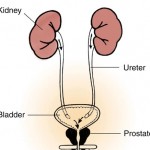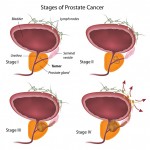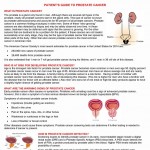SEPA Patient Focus – Prostate Cancer
PATIENT’S GUIDE TO PROSTATE CANCER
WHAT IS PROSTATE CANCER?
The prostate is a gland only found in men. Although there are several cell types in the prostate, nearly all prostate cancers start in the gland cells. This type of cancer is known as prostate adenocarcinoma and accounts for 95  percent of all prostate cancers. Prostate cancer is a common finding at autopsy in older men. Some of these “slow growing” cancers are also detected by biopsy and may be safely observed over time. In these cases, treatment may be deferred until signs that the cancer is growing. For the other cancers that are destined to be a problem for the patient, if these cancers are not treated successfully at an early stage, they may be the type of prostate cancer that can spread to other parts of the body. Other than skin cancer prostate cancer is the most common cancer in American men.
percent of all prostate cancers. Prostate cancer is a common finding at autopsy in older men. Some of these “slow growing” cancers are also detected by biopsy and may be safely observed over time. In these cases, treatment may be deferred until signs that the cancer is growing. For the other cancers that are destined to be a problem for the patient, if these cancers are not treated successfully at an early stage, they may be the type of prostate cancer that can spread to other parts of the body. Other than skin cancer prostate cancer is the most common cancer in American men.
The American Cancer Society’s most recent estimates for prostate cancer in the United States for 2014 are:
- 233,000 new cases of prostate cancer
- 29,400 deaths from prostate cancer
It is also estimated that 1 man in 7 will get prostate cancer during his lifetime, and 1 man in 36 will die of this disease.
WHO IS AT RISK FOR DEVELOPING PROSTATE CANCER?
Age is the strongest risk factor for prostate cancer. Prostate cancer becomes more common in men over age 50. Eighty percent of prostate cancer cases occur in men over the age of 65. African-American men have an above average risk and are nearly twice as likely to die from the disease. A family history of prostate cancer is a risk factor. Having a father or brother with prostate cancer more than doubles a man’s risk of developing this disease. (The risk is higher for men who have a brother with the disease than for those with an affected father.) Also men who eat a lot of red meat or high-fat dairy products appear to have a slightly higher chance of getting prostate cancer.
WHAT ARE THE WARNING SIGNS OF PROSTATE CANCER
Early prostate cancer often causes no symptoms. Problems with urinating could be a sign of advanced prostate cancer, however, this is also a symptom of a less serious disease known as benign prostatic hyperplasia (BPH).
Symptoms of advanced prostate cancer include:
- Impotence (trouble getting an erection)
- Blood in the urine
- Pain in the spine, hips, ribs, or other bones
- Weakness or numbness in the legs or feet
- Loss of bladder or bowel control
Other diseases could cause these symptoms. Prostate cancer screening tests can determine if further testing is needed to determine if cancer is present.
HOW IS PROSTATE CANCER DETECTED?
 Screening exams to identify prostate cancer in its early, most treatable stage include a digital rectal exam (DRE) and a Prostate Specific Antigen (PSA) blood test. A PSA exam detects the level of PSA, a protein produced by prostate cells in the blood. Higher PSA levels indicate the possibility of cancer.
Screening exams to identify prostate cancer in its early, most treatable stage include a digital rectal exam (DRE) and a Prostate Specific Antigen (PSA) blood test. A PSA exam detects the level of PSA, a protein produced by prostate cells in the blood. Higher PSA levels indicate the possibility of cancer.
If you are 50 years old and are in good health, you should speak with your primary care physician about receiving a PSA blood test and digital rectal exam each year to screen for prostate cancer. Men at a high risk, including African-American men and those who have a close relative (father, brother, or son) who had prostate cancer before age 65, should begin testing at age 45.
WHAT ARE THE TREATMENT OPTIONS FOR PROSTATE CANCER
Once your prostate cancer has been diagnosis and staged, You have a lot think about before you and your doctor select a treatment plan.
Prostate cancer is treated through one or more of the following:
- Active surveillance
- Surgery
- Chemotherapy
- Hormonal therapy
- Cryosurgery
- Radiation therapy
Active surveillance is most appropriate for older men with low-grade tumors, involving a smaller amount of biopsy tissue, and low PSA readings that are stable over time. With this approach, men hope to outlive the slow-growing cancer and avoid treatments and side effects including incontinence and impotence. Men choosing active surveillance should receive DREs or PSAs every three to six months and may need periodic biopsies, as well.
If the results of the DRE and/or PSA are not within normal range and a biopsy is performed, a pathologist will assign a Gleason grade if cancer is identified. This important number, which ranges from 2 (best) to 10 (worst), is a strong measure of how aggressive the prostate cancer is and can be used to help determine prognosis and treatment options. It is important to note that although the Gleason grade can range from 2 to 10, most biopsies are at least a 6 which is still considered a low grade or well differentiated tumor.
The most common treatment for prostate cancer is surgery, which can remove the cancerous prostate from the body. Surgery is generally recommended for men with early stage cancer but is sometimes used at advanced stages to relieve symptoms. The most common surgical procedure is radical prostatectomy the removal of the entire prostate gland.
Radiation therapy can be used to treat men with small tumors confined to the prostate, as well as to relieve symptoms in advanced tumors. In one type of radiation therapy, brachytherapy, a surgeon implants radioactive pellets inside the prostate. Over time, the pellets radiate the prostate and surrounding tissue, killing the cancer cells. However, brachytherapy may not be as effective in men with large prostates. Another kind of radiation therapy is external beam radiation in which high-energy beams pinpoint and kill cancer cells.
Cryosurgery (also called cryotherapy or cryoablation) is sometimes used to treat early stage prostate cancer by freezing it. As with brachytherapy, this may not be a good option for men with large prostate glands.
Physicians use hormonal therapy to reduce the amount of testosterone, which prostate cancers need to grow. Hormone therapy cannot cure cancer but can delay its growth and provide symptomatic relief.
If the cancer has spread (usually to bones) and is no longer responsive to hormonal therapy, chemotherapy can be considered. This treatment delivers drugs throughout the body, slows the cancer’s progression, and reduces pain.
HOW CAN I PREVENT PROSTATE CANCER?
Because the exact cause of prostate cancer is not known, it is not possible to prevent most cases of the disease. In addition, some of the risk factors associated with prostate cancer, such as age and family history cannot be  changed. However, some research has shown that eating a diet high in fruits and vegetables (especially tomatoes , cruciferous vegetables, soy, beans, and other legumes), participating in moderate exercise, and maintaining a healthy weight, may help to reduce the risk of developing prostate cancer.
changed. However, some research has shown that eating a diet high in fruits and vegetables (especially tomatoes , cruciferous vegetables, soy, beans, and other legumes), participating in moderate exercise, and maintaining a healthy weight, may help to reduce the risk of developing prostate cancer.
WHERE CAN I FIND MORE INFORMATION?
Click on image below to download your own printable copy of this handout



